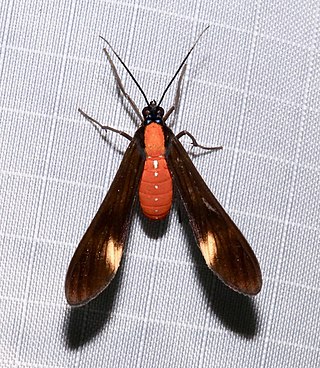
Rhynchopyga is a genus of moths in the subfamily Arctiinae.
Rhynchopyga albigutta is a species of moth in the subfamily Arctiinae. It is found in Peru.
Rhynchopyga bicolor is a species of moth in the subfamily Arctiinae. It is found in Ecuador.
Rhynchopyga braconida is a species of moth in the subfamily Arctiinae. It was described by William James Kaye in 1911. It is found in São Paulo, Brazil.
Rhynchopyga discalba is a species of moth in the subfamily Arctiinae. It was described by William James Kaye in 1918.

Rhynchopyga elongata is a species of moth in the subfamily Arctiinae. It is found in Ecuador.

Rhynchopyga flavicollis is a species of moth in the subfamily Arctiinae. It is found in Guatemala.
Rhynchopyga garleppi is a species of moth in the subfamily Arctiinae. It is found in Bolivia.
Rhynchopyga hymenopteridia is a species of moth in the subfamily Arctiinae. It is found in Bolivia.
Rhynchopyga ichneumonea is a species of moth in the subfamily Arctiinae. It is found in Colombia.

Rhynchopyga meisteri is a moth in the subfamily Arctiinae. It is found in Brazil and Argentina.
Rhynchopyga metaphaea is a moth in the subfamily Arctiinae. It is found in Mexico.
Rhynchopyga rubricincta is a species of moth in the subfamily Arctiinae. It is found in Bolivia.
Rhynchopyga semibrunnea is a species of moth in the subfamily Arctiinae. It is found in Bolivia.
Rhynchopyga xanthospila is a moth in the subfamily Arctiinae. It is found in Bolivia.
Rhynchopyga xanthozona is a species of moth in the subfamily Arctiinae. It is found in Bolivia.

The Euchromiina are a subtribe of tiger moths in the family Erebidae. It was described by Arthur Gardiner Butler in 1876. Many species in the subtribe are mimics of wasps. Euchromiina have always been considered closely related to the subtribe Ctenuchina due to their similarity to moths and wasps. These two subtribes make up around 3,000 valid species, the majority of which occur in the Neotropics.




